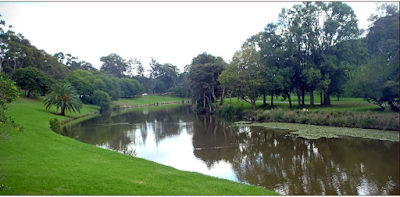Gate
House
Gatehouses are part of the evolution of the Park from Governor’s
Domain to Parramatta Park. There are 6 gatehouses in Parramatta Park:
George Street Gatehouse - Tudor Gatehouse – Grand entrance
Ross Street Gatehouse
Park Road Gatehouse
Macquarie Street Gatehouse - Tea Room – Gothic-style
Great Western Hwy Gatehouse – Mays Hill
Queens Road Gatehouse
Bath
House
The bath house was built in 1823. The Governors Bath House has
intricate exposed timber work within the internal roof structure and large
sandstone paving under foot. Due
to his war wounds, Governor Brisbane wanted a private place with warm baths.
This Bath House is convict built heating and pumping system. In 1886,
Parramatta Park Trustees converted the Bath House to Pavilion.
William
Hart Memorial
William Edward Hart was born on 20 April 1885 at Parramatta. He
was first Australian to fly a plane and first qualified pilot in Australia. On
29 June, 1911 Billy won Australia's
first air race when he defeated the American A. B. Stone from Botany to
Parramatta Park.
Dairy
Cottage
The Dairy
Cottage is one of Australia’s oldest surviving colonial buildings and offers a
glimpse back into Australia’s past. Dairy
Cottage was constructed between 1798 and 1805 by ex-convict George Salter. In
1811 – 1815 Governor Macquarie purchased George Salter’s land and converted
this cottage to Diary. Dairy Cottage is rare intact structure of European
settlement. Dairy Cottage remains unchanged since c1820.
Boer War Memorial
Boer
War Memorial was erected in 1904. This is in memory of first Australian troops
to arrive in Africa in 1899 from Lancer Barracks Parramatta to take part in
Boer War. This was the first overseas military engagement in which troops were
representing Australia.
Lady
Fitzroy Memorial
Memorial erected near the site of the carriage accident on 7
December 1847 which took the life of Lady Mary Fitzroy, wife of the Governor
and aide de camp Lieutenant Charles Masters. A commemorative Oak tree was
planted to mark the site of the accident. The current oak tree is the third
tree to be planted on the site in c1996.
Government
House
Governor Phillip laid out the area of Domain in 1790 as part of the
settlement of Rose Hill and constructed a small timber cottage for the
Governor’s residence. Nine years later, Governor Hunter replaced the cottage
with two stories Georgian House. This convict built Old
Government House is the oldest surviving public buildings in Australia and is a
World Heritage site. It was the country residence for the first ten governors
of NSW.
The
Crescent
Natural ridgeline which once framed a small billabong on the bank of
the Parramatta River. First Government House in Parramatta was built for
Governor Phillip in 1790 on the ascending hill of The Crescent. Now the
Crescent is used as an event space. This year Tropfest Jr will be held at The
Crescent.
Observatory
Transit Stones
Observatory was built by Governor Macquarie in 1822. Two
marker trees were planted to the south of the of the transit stones with two
additional in the southern domain. All four trees marked as a north-south
alignment across the Governor’s Domain. This was the third observatory built in
Australia. It was at this observatory, first extensive and systematic
cataloguing of Southern Skies were carried out astronomers. The observatory
building was demolished in 1848 with only the transit stones on their plinth
left standing. A 16 inch repeating circle and the 5 foot 6 inch transit
telescope are now on display at the Powerhouse Museum.















